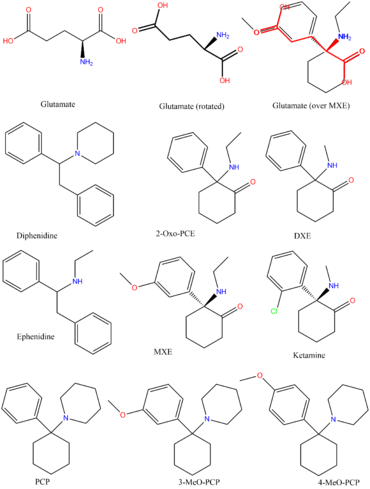UserWiki:StasConstantine/etrДиссоциативы
- (Русский перевод o PsychonautWiki / Russian Translation of PsychonautWiki. Работа в процессе / work in progress.)

Dissociatives refer to a class of hallucinogen which distort sensory perceptions (mainly of sight and sound) to produce feelings of disconnection, detachment, and dissociation from the environment and self. This is done by reducing or blocking signals to the conscious mind from other parts of the brain.[1]
Диссоциативы — это класс галлюциногенов которые искажают восприятия мира и сознания производя чувства разъединения, отчуждения и диссоциации от окружающей среды и себя. Это удается уменьшением или блокированием сигналов от между сознанием и других частей мозга.
Although many classes of psychoactive substances are capable of such action, dissociatives are unique in that they do so in such a way that they produce hallucinogenic effects, which generally include sensory deprivation, dissociation, hallucinations, and dream-like states or trances.[2] Some dissociatives, which are non-selective in action and affect the dopamine[3] and/or opioid[4] systems, may also be capable of inducing euphoria.
Хотя множество классов психоактивных веществ могут произвести такие эффекты, диссоциативы являются уникальныма т.к. они делают это так, что одновременно выробатывают галлюцинации, сенсорную депривацию, диссоциацию, обезличение, состояния на подобе сновидений и транса.
Механизм действия
NMDA receptors within the brain exist to allow for the transfer of electrical signals between neurons in the brain and in the spinal column. For electrical signals to pass, the NMDA receptor must be open. To remain open, the neurotransmitters known as glutamate and glycine must bind to the NMDA receptor. An NMDA receptor that has glycine and glutamate bound to it and has an open ion channel is called "activated."
Dissociatives are classed as NMDA receptor antagonists. This means they bind to the receptor, but do not activate it and block other neurotransmitters from doing so. The result is a dose dependent decrease in the passing of electrical signals across the brain and an overall disconnection of neurons. This leads onto states of disconnection between conscious parts of the brain and its sensory organs as well as out-of-body experiences and accompanying hallucinations.
Эффекты
Disclaimer: The effects listed below cite the Subjective Effect Index (SEI), an open research literature based on anecdotal user reports and the personal analyses of PsychonautWiki contributors. As a result, they should be viewed with a healthy degree of skepticism.
It is also worth noting that these effects will not necessarily occur in a predictable or reliable manner, although higher doses are more liable to induce the full spectrum of effects. Likewise, adverse effects become increasingly likely with higher doses and may include addiction, severe injury, or death ☠.
Влияния на зрение 
-
Подавления
-
Искажения
-
Геометрия
In comparison to other classes of hallucinogen, this effect is significantly less complex and intricate with a limited range of effects. It does not extend beyond level 4 and is variable within most of its variations but is exclusively simplistic in complexity, unstructured in organization, dimly lit in lighting, slow in movement and immersive in depth.
-
Галлюцинаторные состояния
External hallucinations
In comparison to other classes of hallucinogen, this effect can occur at heavy dosages, but is extremely infrequent in comparison to the same effect found within deliriants.It can be comprehensively described through its variations as delirious in believability, autonomous in controllability and solid in appearance.
The most common theme for this effect to follow is one of experiencing and talking to friends around oneself when they are not actually present.
Internal hallucinations
In comparison to other classes of hallucinogen, this effect can occur at heavy dosages but is considerably less common than the same effect found within psychedelics and deliriants.It can be comprehensively described through its variations as delirious in believability, fixed in style, equal in new experiences and memory replays in content, autonomous in controllability and solid in appearance.
Разъединения 
Влияния на сознание 
-
- Подавление формирования памяти
- Conceptual thinking
- Déjà vu
- Depersonalization
- Derealization
- Усиление сновидений
- Increased music appreciation
- Information processing suppression
- Introspection
- Подавление памяти
- Personal bias suppression
- Subconscious communication
- Соединение мыслей
- Замедление мыслей
- Мысленные петли
- Искажение времяни
- Unity and interconnectedness
Физические эффекты 
Влияния на слух 
Multisensory effects 
Фармакологические группы
Morphinans
-
- Декстрометорфан (DXM)
- Декстрорфан (DXO)
Conantokins Peptides
-
- Conantokin-G (Con-G)
- Conantokin-T (Con-T)
- Conantokin-R (Con-R)
- Conantokin-L (Con-L)
- Conantokin-P (Con-Pr1, Con-Pr2 and Con-Pr3)
- Conantokin-Rl-A(Con-Rl-A)
- Conantokin-Br(Con-Br)
See also
References
- ↑ PCP-induced alterations in cerebral glucose utilization in rat brain: blockade by metaphit, a PCP-receptor-acylating agent.| http://www.ncbi.nlm.nih.gov/pubmed/2850626
- ↑ Snyder, Solomon H. (1980). "Phencyclidine". Nature 285 (5764): 355–6. | http://www.nature.com/nature/journal/v285/n5764/abs/285355a0.html
- ↑ Giannini, A. James; Nageotte, Catherine; Loiselle, Robert H.; Malone, Donald A.; Price, William A. (1984). "Comparison of Chlorpromazine, Haloperidol and Pimozide in the Treatment of Phencyclidine Psychosis: Da-2 Receptor Specificity". Clinical Toxicology 22 (6): 573–9. (PubMed.gov / NCBI) | http://www.ncbi.nlm.nih.gov/pubmed/6725621
- ↑ Giannini, A. James; Underwood, Ned A.; Condon, Maggie (2000). "Acute Ketamine Intoxication Treated by Haloperidol". American Journal of Therapeutics 7 (6): 389–91. (PubMed.gov / NCBI) | http://www.ncbi.nlm.nih.gov/pubmed/11304647